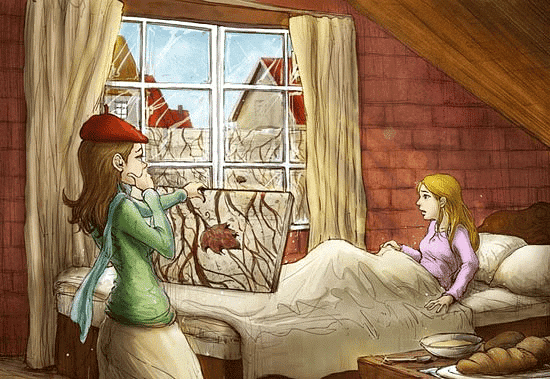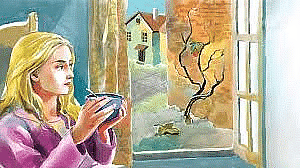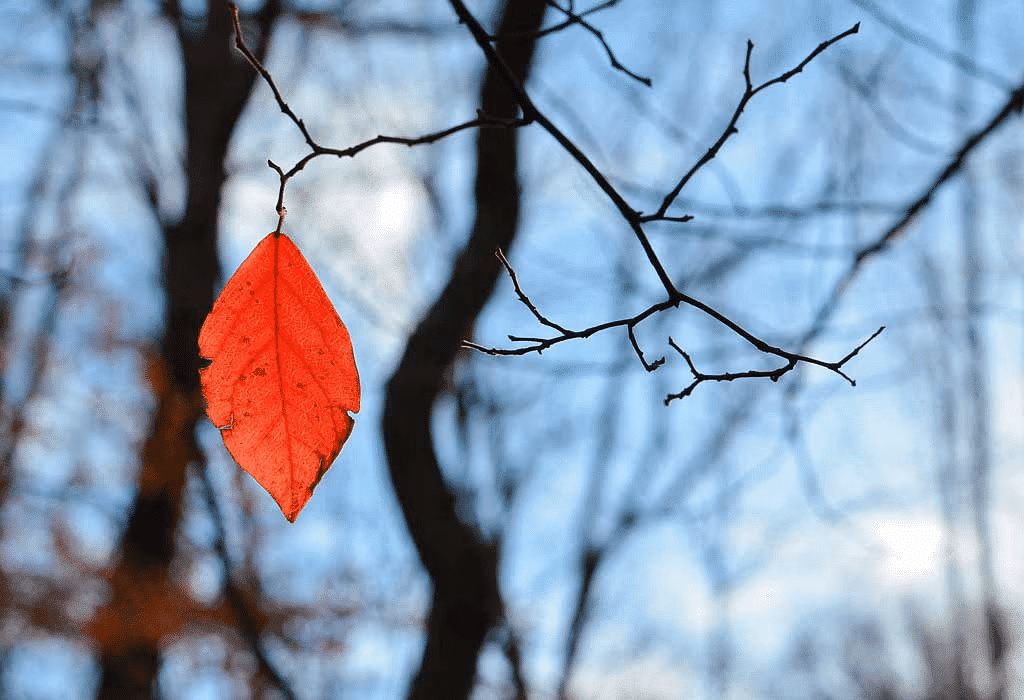Class 9 Moments Supplementary Reader Chapter 7 Question Answers - The Last Leaf
Q1. What is Johnsy’s illness? What can cure her – the medicine or her willingness to live?
Ans: Johnsy suffered from pneumonia during the cold month of November. This illness left her both physically weak and mentally depressed. She spent her days in bed, staring out of the window and watching the autumn leaves fall. Johnsy believed that when the last leaf fell, she would die, which deepened her negative mindset and worsened her condition. She refused to eat and lost all hope, rendering the medicines ineffective. The doctor indicated that her recovery relied on her willingness to live. Without the desire to improve, even the best medicine could not help her.

Q2. Sue is a true and faithful friend. Comment.
Ans: Sue exemplifies the qualities of a true and loyal friend. She and Johnsy, both young artists, shared a flat. When Johnsy fell ill, Sue devoted herself to caring for her. She called the doctor daily and earned money by painting beside Johnsy's bed, all while maintaining a cheerful attitude to uplift her friend. Sue was patient with Johnsy's gloomy outlook and reassured her that the falling ivy leaves had no connection to her illness. Recognising the seriousness of the situation, she sought help from Behrman. Sue’s compassion and support reflect her loyalty and genuine concern for Johnsy's well-being.
Q3. Do you think the feeling of depression Johnsy has is common among teenagers?
Ans: Yes, Johnsy’s feeling of depression is common among teenagers. Like Johnsy, many teenagers struggle with emotional maturity, making it hard for them to cope with unpredictable and challenging situations. This often leads to negative thoughts and fears, creating a cycle of pessimism and anxiety. Such emotional instability can impact their health and diminish their willpower. Moreover, teenagers can be challenging to counsel, often testing the patience of those around them. A lack of a healthy lifestyle can worsen their depression. To combat this, teenagers should focus on positive habits such as meditation, exercise, and cultivating optimism to maintain a balanced mental state.
Q4. How did Behrman save Johnsy’s life?
Ans: Behrman saved Johnsy's life through an extraordinary act of self-sacrifice. Despite being a sixty-year-old unsuccessful artist, he took it upon himself to help Johnsy when she believed she would die as the last leaf on the ivy vine fell. On a stormy night, just as the last leaf was about to drop, Behrman braved the cold and rain to paint a realistic green leaf on the wall. This act gave Johnsy the hope and will to live. Unfortunately, Behrman caught pneumonia from the exposure and passed away shortly after. His painting of the last leaf became his ultimate masterpiece, symbolising his dedication to art and his compassion for Johnsy.
Q5. Imagine Behrman survives the attack of pneumonia. His family takes him back to his native countryside to nurse him back to health. As Johnsy, write a letter to Behrman expressing your gratitude.
Ans:
(Date)
2-111 Floor Ivy Apartments
London
Dear Mr. Behrman,
I hope this letter finds you in better health. Sue and I think of you often and miss your presence in the neighborhood. You have always been a kind and talented gentleman, and words cannot express my gratitude for your extraordinary help during my darkest moments. I shudder when I remember how you risked your life for me—a foolish girl, blinded by hopelessness. Your courage and dedication have taught me the true value of life and art.
Your masterpiece has not only saved my life but also inspired me to cherish each day. I promise never to let despair cloud my thoughts again. Sue and I wish you a speedy recovery and look forward to seeing you create more masterpieces.
With warm regards,
Johnsy
Q6. Describe briefly how Behrman saved Johnsy’s life.
Ans: Johnsy was suffering from pneumonia and believed she would die when the last leaf on the ivy creeper fell. The doctor indicated that her recovery relied on her will to live. Behrman, an elderly painter living in the same building, learned of Johnsy's belief and decided to help her. On a stormy night, as the last leaf fell, Behrman painted a realistic leaf on the wall. The next morning, Johnsy saw the leaf and regained her will to live. Tragically, Behrman caught pneumonia while painting and died, but his selfless act ultimately saved Johnsy's life.
Q7. In “The Last Leaf” why did Sue cry bitterly when the doctor had gone? Later she walked into Johnsy’s room whistling a cheerful tune. Why?
Ans: Sue was heartbroken after the doctor informed her that Johnsy's chances of survival were slim unless she regained the will to live. Overwhelmed by the situation, she cried bitterly once the doctor left. However, Sue realised that displaying her sadness would only worsen Johnsy's condition. To uplift her friend's spirits and instil hope, Sue entered Johnsy's room whistling a cheerful tune, aiming to encourage her recovery.
Q8. What did Johnsy believe about the falling leaves? Did Sue believe the same thing?
Ans: Johnsy believed that her life was linked to the falling ivy leaves. She thought that when the last leaf fell, she would die. In contrast, Sue did not share this belief. She tried to reassure Johnsy that the leaves had no bearing on her life and cared for her deeply. Sue sought the help of Behrman, whose painted leaf ultimately saved Johnsy’s life.
Q9. Write a brief character sketch of old Behrman.
Ans: Old Behrman was an unsuccessful artist in his sixties who had always dreamed of creating a masterpiece but never began one. He lived below Johnsy and Sue's flat and saw himself as their protector. Although he often seemed gruff, he was genuinely kind and caring. When Johnsy believed she would die with the fall of the last leaf, Behrman painted a leaf on the wall during a stormy night, risking his own life in the process. His act of painting the last leaf demonstrated his selflessness and kindness, ultimately becoming his long-awaited masterpiece.
Q10. Justify the title of the story ‘The Last Leaf ‘.
Ans: The title The Last Leaf is crucial to the story's theme and plot. Johnsy, a young artist, believes her life is tied to the leaves of the ivy creeper outside her window. She is convinced that she will die when the last leaf falls. However, Behrman, an elderly painter, paints a leaf on the wall just as the last real leaf drops. This act gives Johnsy hope and the desire to live. Although the last leaf is artificial, it plays a vital role in saving her life, making the title particularly fitting for the story.

Q11. Draw a brief character sketch of Sue.
Ans: Sue is a central character in the story The Last Leaf. She is an artist sharing a studio with her friend Johnsy in an artists' colony. Sue is depicted as kind-hearted, selfless, and a devoted friend. When Johnsy falls ill with pneumonia, Sue becomes her caregiver, tending to her with love and dedication. She works tirelessly, both day and night, to earn enough money for Johnsy's medicine and proper nutrition. Despite feeling distressed when the doctor mentions Johnsy’s slim chances of recovery, Sue remains hopeful. She tries to lift Johnsy’s spirits by dismissing her belief that she will die when the last leaf on the vine falls. Sue’s compassion, loyalty, and determination to save her friend define her as a true friend and a noble individual.
Q12. Behrman’s masterpiece helped Johnsy survive. Explain how the last leaf influenced Johnsy.
Ans: Behrman’s masterpiece plays a crucial role in Johnsy’s survival. Behrman, an elderly artist, had always dreamed of creating a masterpiece. When he discovered that Johnsy, who was seriously ill, believed her life depended on the falling leaves of a vine, he decided to help her. On a stormy night, Behrman painted a leaf on the wall that looked just like the last leaf of the creeper. Johnsy thought that the leaf's refusal to fall inspired her with a new sense of hope, which ultimately motivated her to fight her illness. Tragically, Behrman caught pneumonia while painting in the cold and died shortly after. His selfless act and sacrifice instilled in Johnsy the will to live, making his final painting his true masterpiece.
Q13. Johnsy felt her survival was related to the falling ivy leaves. Explain how blind beliefs can harm us.
Ans: Johnsy's belief that her life was linked to the falling leaves of a vine shows the dangers of superstitions. While suffering from pneumonia, she became fixated on the idea that she would die when the last leaf fell. This irrational belief deepened her depression and diminished her will to live. Despite the doctor's assurance that her recovery relied on her desire to live, Johnsy remained trapped in her superstition. This situation illustrates how blind beliefs can hinder individuals from confronting their challenges and may even threaten their lives.
Q14. Sue played a very important role in saving her friend Johnsy. Explain how she acted as a trusted friend.
Ans: Sue's role as a trusted friend is clear throughout the story. When Johnsy fell ill, Sue took on the responsibility of nursing her back to health. She provided comfort and worked tirelessly to lift Johnsy's spirits, refusing to let her friend fall into despair. Sue kept Johnsy company, distracting her from negative thoughts, and sought help from Behrman when Johnsy's condition worsened. Her care and persistence were crucial to Johnsy's recovery. Sue's actions exemplify the qualities of a devoted friend, willing to go to great lengths to support someone she cares about. She encouraged Johnsy to engage with the world around her, even bringing her drawing board into the room to create a more uplifting atmosphere. When Johnsy expressed her fears about the last leaf falling, Sue remained hopeful and reassured her, highlighting the importance of friendship and support in difficult times.
Q15. “A friend in need is a friend indeed.” Do you think the story The Last Leaf supports this statement?
Ans: Yes, The Last Leaf strongly supports the idea that A friend in need is a friend indeed. When Johnsy was critically ill, her friend Sue stayed by her side, providing comfort and support. Johnsy believed she would die when the last leaf fell, which led her to despair. However, Sue remained hopeful and did everything possible to encourage her. She even sought Behrman’s help when she feared for Johnsy's life. Behrman demonstrated true friendship by painting a leaf on the vine to restore Johnsy’s hope. The actions of both Sue and Behrman highlight the strength of friendship during difficult times.
Q16. “You have to live for your friends.” How far do you agree with this advice given by Sue to Johnsy?
Ans: Sue’s advice to Johnsy, “You have to live for your friends,” highlights their strong bond. The doctor indicated that Johnsy would not recover without a willingness to live. Sue recognised that love for others can provide the strength needed to persevere. Johnsy's depression had stripped her of her desire to live, but Sue’s words aimed to rekindle her hope. The last leaf on the creeper symbolised resilience, encouraging Johnsy to fight against her illness and reconsider her outlook on life.
Q17. What is the need to maintain a positive attitude in life? Comment with reference to Johnsy’s attitude.
Ans: Maintaining a positive attitude is essential in life, as it influences our ability to face challenges. In Johnsy's situation, her negative outlook greatly affected her health. She became fixated on the idea that she would die when the last leaf fell, which diminished her will to fight her illness. Despite the doctor's efforts, Johnsy's condition deteriorated due to her depression and lack of hope. However, when she realised that the last leaf had not fallen, her perspective shifted, leading to her recovery. Johnsy's experience highlights how a positive attitude can significantly impact one’s survival and overall well-being.
Q18. The Last Leaf is a story of supreme sacrifice by an old artist. Do you agree?
Ans: Yes, The Last Leaf is indeed a story of supreme sacrifice. Behrman, an old artist, had always dreamed of painting a masterpiece. When he discovered that Johnsy's life was at risk because she believed she would die when the last leaf fell, he selflessly chose to paint a leaf on the wall to save her. Braving the cold during a stormy night, he created a lifelike image of a leaf, giving Johnsy the hope she needed to survive. Tragically, Behrman contracted pneumonia and passed away shortly after. His ultimate sacrifice—giving his life to save another—makes this a story of profound selflessness.
|
120 videos|624 docs|82 tests
|
FAQs on Class 9 Moments Supplementary Reader Chapter 7 Question Answers - The Last Leaf
| 1. What is the main theme of "The Last Leaf"? |  |
| 2. Who are the main characters in "The Last Leaf"? |  |
| 3. How does Behrman's act of painting the last leaf affect Johnsy? |  |
| 4. What role does symbolism play in "The Last Leaf"? |  |
| 5. What message does O. Henry convey through the ending of "The Last Leaf"? |  |


















